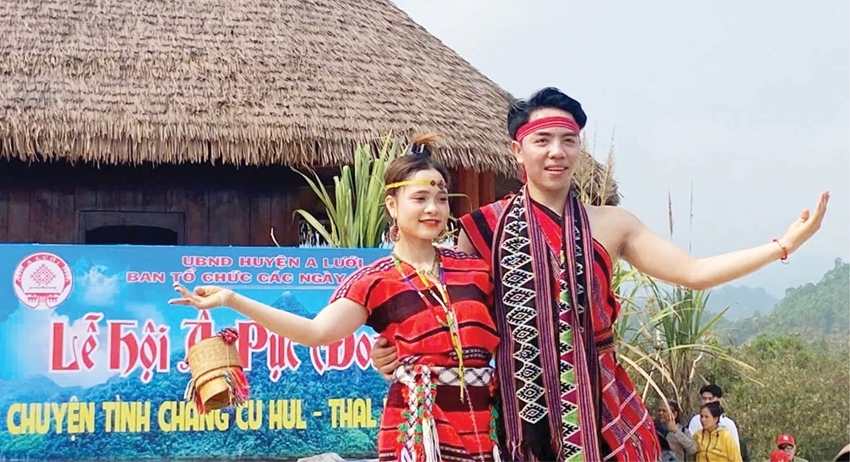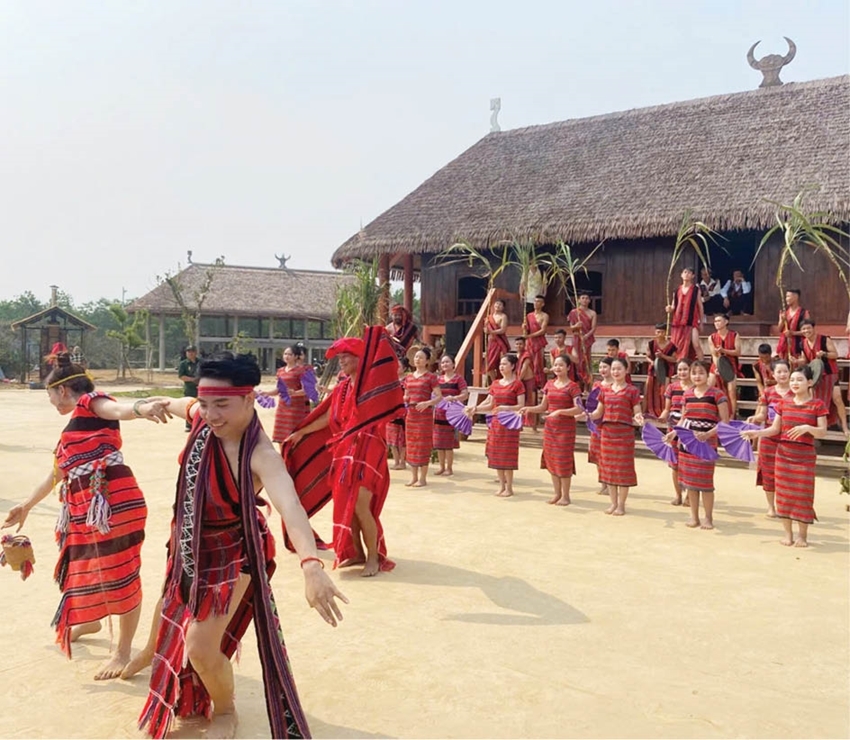 |
| A scene from the Ar Puc Festival |
Story from old villages of A Le and A Lin
Though it may be forgotten by some, the love story of Cu Hun, Thail, and Klai remains vivid in the hearts of A Luoi locals. Artisan Ta Du Tur spent weeks collecting accounts from village elders Quynh Quen and Quynh Sao in A Nam Village, Hong Van Commune, and Ho Van Hanh in An Trieng Village, Trung Son Commune, to document this true story that unfolded by the gentle Pliing River.
The story goes that, long ago in the Pa Co village of A Lin, there lived a beautiful young woman named Klai, whose charm captured the hearts of many local suitors, including the brave Cu Hun. However, Klai’s heart had already been claimed by the handsome Thail from A Le village. On bright moonlit nights, Thail would climb the Ri Hang slope to Sim Village, beside the Pliing River, where he and Klai would meet, exchanging words of love: “Thail, my love, Klai, my heart! For many moons, we’ve vowed to be together, destined to share a lifetime … Hand in hand, we will journey to the ends of the earth, never to part, until our hair turns white and our teeth fall out.”
 |
| A moment captured at the Ar Puc Festival |
At that moment, unable to resist Klai’s beauty—brighter than the full moon—Cu Hun took her from the stream and brought her home as his wife, ignoring her cries and pleas. Grief-stricken, Thail pleaded with Cu Hun to set her free. But Cu Hun refused, and the two clashed for many moons. As the conflict grew more serious, Thail’s clan reported the matter to the village elder of A Le in search of a resolution. In response, the elders of A Le and A Lin summoned allied village elders from neighboring communities to gather and find a solution.
The village elders gathered to perform the Ar Puc ceremony, enacting the sacred ritual of catching the chicken tied atop the ceremonial neu pole (a tall, decorated ritual pole erected during traditional festivals)—an emblem of inter-village unity. They appointed the most reputable and impartial elder to preside over the proceedings. He proclaimed: “Let Thail bear Klai upon his back and race toward the peak of Mount Ri Hang. Should he reach the summit alive, he shall be granted the right to take Klai as his wife.”
Young artists amid mountains and forests
The story grew ever more dramatic, stirring the hearts of a swelling crowd of onlookers. Amid the season when sim blossoms dyed the hills of A Luoi a deep purple, and the spring sunlight stretched endlessly across the mountain ridges, thousands of villagers and visitors converged, pressing close to witness the festival. Both sides of the hillside were packed with people—young and old, men and women—witnessing the fierce contest between Thail and Cu Hun. The beat of drums and the clang of gongs from the village boys urged them on. Under a scorching sun, Thail bore Klai on his back, racing up the mountain. But midway up the slope, exhaustion and thirst began to overtake him.
Fortunately, before the contest began, Klai had cleverly gone down to the Pliing River to wash her hair, letting the cool water soak into her long tresses. Now, as Thail faltered, she let down her hair and draped it over his shoulder, letting him sip the water clinging to the strands:
“My hair has soaked in the river’s sweet flow.
Drink now, my love, for strength to grow.
O Ri Hang, stir the hearts of these lovers,
That they may conquer the fierce slope of love.”
Revived by the cool water, Thail regained strength and carried Klai up the mountainside. Cu Hun, parched and weary, collapsed along the way. In the end, Thail and Klai gently helped him back to the village.
The village elders welcomed Thail, Klai, and Cu Hun to perform the ritual of commitment. Each elder prepared a bamboo tube, each one symbolizing the commitment of the two villages before the council of elders. Quynh Thieng (from Quang Nham village) acted as the head elder and said: “O village A Le, Thail, Klai, and village A Lin, Cu Hun (A cap pa xat coai bi dang cu du), the matter is now settled, and the past shall not be mentioned again. From this day forward, the two villages shall live in harmony, unity, and love for one another. Should the two villages, or the two young men, fail to uphold this commitment, the council of elders will bring these bamboo tubes as evidence to remind them, and impose a stricter penalty.”
The cast who reenacted the Ar Puc festival were strikingly beautiful. Their performances were deeply immersive-on par with professional actors. And yet, they are sons and daughters of the mountains and forests: Ho Hai Nguyen, who played Cu Hul, is from A Huor Pa E Hamlet, Quang Nham Commune, and serves as Secretary of the Youth Union; Ho Van Trang, who portrayed Thail, hails from Dut Hamlet, Le Trieng 2, Trung Son Commune, also a Youth Union Secretary; and A Viet Thi Tien, who played the role of Klai, comes from A Nam Hamlet, Hong Van Commune, and is a teacher at Hong Van Kindergarten.
Artisan A Rel Thuy Linh, who directed the stage performance based on a script by Meritorious Artisan Ta Dur Tu, remarked: “The young performers trained with great passion and revealed remarkable talent. In the final scene, both the Moon and the Fairy appeared in strikingly beautiful forms. It seems that every A Luoi native carries an artist within. Once awakened, that inner artist naturally steps into the spotlight.”
Hey Moon, was it exhausting to play Thail, carrying Fairy (Klai) on your back?
Yes, it was tiring, but we were overjoyed. To embody the image of a courageous and resilient ancestor from long ago, I gave it my all, hoping to make it as beautiful as I could. I believe the audience will grow to appreciate and treasure the traditional figure of A Luoi’s highland people even more.”
And as for A Viet Thi Tien, word has it that she’s been growing her hair out for the past six months just to play Klai.
Meritorious Artisan Ta Dur Tu said: “There’s a talented young generation in A Luoi. They are passionate and put in a lot of effort to revive the heritage of their ancestors. Have you seen the Zeng fashion shows? The performers aren’t from the cities; they’re actually preschool teachers from A Luoi.”
A Luoi is gradually succeeding in reviving its heritage at risk of fading away. Dedicated researchers such as Ke Suu, Pa Co Them, and Ta Dur Tu, along with skilled artisans like Ho Nam, Ho Van Hanh, and Per Prung Dai, are always ready to lend their support. Meanwhile, talented and passionate community performers like Trang, Tien, and Nguyen are contributing to breathing new life into A Luoi’s ancient festivals day by day.